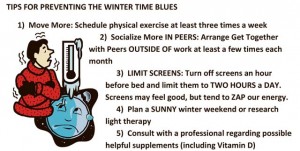Most of us dread the cold and darkness of winter. Sure, we’ve got warm boots, fluffy scarves, and big coats to combat the cold, but many of us feel empty handed when it comes to battling the blues that often come with the season. We can feel drained, tired or joyless. We struggle to get out of bed in the morning and often can’t wait to return to it once we get home. We don’t want to go out, even for date nights or to special events, and a lot of the time, we find ourselves in bad moods.
It’s that time of year when some of us show signs of Seasonal Affective Disorder (SAD). At the beginning of the season, the symptoms tend to be more mild. They get worse the more time we spend without sunlight and worsen in the middle of winter.
 Symptoms look a lot like depression: sadness, anxiety, loss of interest in usual activities, withdrawal from social activities and an inability to concentrate. The difference, though, is that these symptoms resolve each spring and tend to occur again in late fall.
Symptoms look a lot like depression: sadness, anxiety, loss of interest in usual activities, withdrawal from social activities and an inability to concentrate. The difference, though, is that these symptoms resolve each spring and tend to occur again in late fall.
One way to differentiate SAD from depression is to look at personal history. Do you feel low and isolated almost every winter? By early spring, or the first few days of sunlight, do your symptoms resolve? Also, analyzing your sleeping habits can help. Individuals with SAD report sleeping an average of 2.5 hours more a night in winter than in the summer. The general population sleeps 0.7 hours more a night in the winter.
Similar to many mental health disorders, genetics, age, gender, geographical location and levels of certain brain “chemicals” play a role in developing the condition. Specific factors that often contribute to the condition include:
• Changes in your biological clock (circadian rhythm) and melatonin levels may alter your mood and energy levels.
• Less sunlight can cause a drop in serotonin, a neurotransmitter, which may trigger depression.
• SAD is diagnosed more often in women than in men, but men may have symptoms that are more severe.
• SAD is diagnosed more among people who live far north or south of the equator.
• People diagnosed with SAD may be more likely to have blood relatives with the condition.
Before you crawl back into bed, consider some ways to deal with to the winter blues.
It’s normal during winter to have some days where you want to hibernate and isolate yourself. If you find that you’ve gone a few weeks without socializing, don’t enjoy time with your children, have an increased need for sleep or that you frequently turn to alcohol for comfort, it is time to consult with your medical provider.
A medical provider can also educate you about several natural supplements that may help with SAD symptoms. Most people find scheduled, regular exercise increases energy levels during winter. In addition, scheduling social outings outside of work at least bimonthly can give you a boost. Have a regularly occurring bimonthly potluck, game night or communal TV series get together. If possible, take a trip to a warm, sunny location in mid winter. Other helpful remedies include acupuncture, yoga and light therapy.
Take a proactive approach and implement these strategies early in the winter season to prevent symptoms from getting worse over time. So, call your friends, consult with your medical provider and plan that sunny vacation for February now.
(Dr. Krystal White is a pediatric psychologist at Landstuhl Regional Medical Center, who specializes in community assets and developmental disorders)







